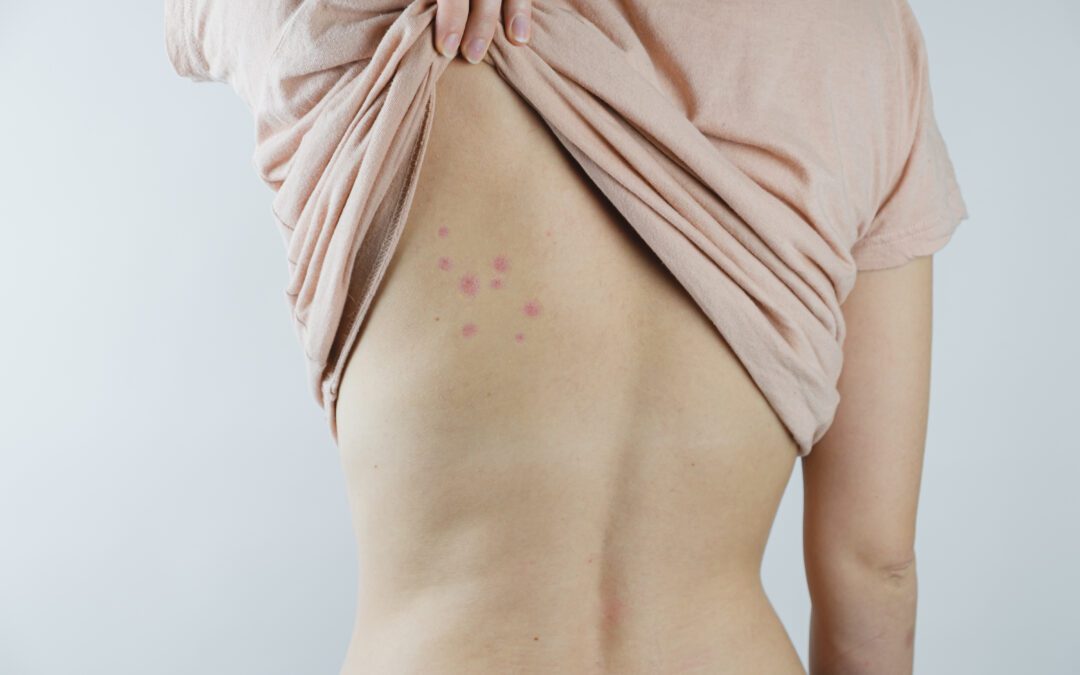Imagine a peaceful slumber interrupted by an unseen adversary, causing you to ask, “What does a bed bug bite look like?” Today, we unpack this mystery, discussing these tiny nocturnal invaders, how their bites are present, and the remedies at your disposal.
Understanding Bed Bugs and Their Bites
Often compared to the size of an apple seed, bed bugs are brown and flat, transforming into a redder and swollen version of themselves after a feeding session. These pests prefer dark, secluded corners of your house, particularly your bed. They are nocturnal creatures and make the most of your dormant state, feeding on your blood almost undetected.
Bed bugs have been a part of human settlements for thousands of years, cohabiting and feeding on us. While they don’t transmit diseases, their bites can lead to various skin reactions and, in some cases, psychological effects, including stress and insomnia.
Identifying Bed Bug Bites
Identifying a bed bug bite can be quite the detective task, considering how they can be easily mistaken for mosquito or flea bites. Typically, bed bug bites appear as small, red, itchy welts. They often present in a line or a zigzag pattern, thanks to the bug’s habit of feasting in one spot.
However, the appearance of bites alone is insufficient to confirm bed bugs’ presence. Other signs to look out for include:
- Tiny blood stains.
- Bug excrement on your sheets.
- Actual sightings of the bugs themselves.
Common Reactions to Bed Bug Bites
Human reactions to bed bug bites are diverse. Some lucky individuals might not exhibit symptoms, while others might have mild to severe reactions. Mild reactions often include discomfort and itchiness, while severe reactions could include rashes and even allergic responses.
Psychologically, knowing you’re sharing your bed with these pests can lead to stress, anxiety, and sleep disturbances. Addressing the infestation early is crucial to avoid potential complications and restore peace to your nights.
Treating Bed Bug Bites
Upon discovering bed bug bites, wash the area with soap and water to prevent secondary infections. To manage itchiness and swelling, over-the-counter creams can provide relief. However, not giving in to the urge to scratch is essential, as this can exacerbate the problem.
In cases of severe symptoms, seek medical attention promptly. Your healthcare provider can prescribe antihistamines or corticosteroids to manage allergic reactions and even antibiotics if an infection occurs due to scratching.
Home Remedies and Natural Treatments
If you’re more inclined toward natural remedies, there are options abound.
Aloe Vera: The gel from this plant is known for its anti-inflammatory and antibacterial properties, which can help reduce swelling and prevent infection. Apply the gel directly to the bite and let it dry.
Baking Soda Paste: Baking soda, or sodium bicarbonate, can neutralize the pH of an affected area, helping to soothe itchiness. Mix baking soda with a little water to create a paste, apply it to the bites, and leave it on for about 10 minutes before washing it off.
Essential Oils: Essential oils, like tea tree oil, lavender oil, or peppermint oil, have natural anti-inflammatory properties. They can help reduce itching and swelling caused by bed bug bites. Dilute a few drops in carrier oil (like coconut or jojoba oil) and apply it to the affected areas.
Oatmeal Bath: Colloidal oatmeal has anti-irritant and anti-inflammatory properties, making it great for soothing skin irritations and itchiness. You can add it to your bathwater and soak it for the best results.
Cucumber Slices or Peels: Cucumbers have natural astringent and cooling properties, which can help soothe itching and inflammation. Apply fresh slices or peels to the bites.
Honey: Known for its antibacterial and anti-inflammatory properties, applying a small amount of honey to the affected area can help reduce inflammation and prevent infections.
Apple Cider Vinegar: Like baking soda, apple cider vinegar can help balance the pH of the skin, which can help soothe itchiness from bed bug bites. Dab a bit onto the bites with a cotton ball.
Cold Compress: A cold pack or a cloth dipped in cold water applied to the bites can help reduce swelling and numb the area, providing temporary relief from itching.
Remember, while these remedies can offer relief from the symptoms of bed bug bites, they don’t address the root cause, which is the bed bug infestation itself. Consulting a bed bug removal professional is advisable to eliminate the problem effectively.
Seeking Professional Assistance
Attempting to deal with a bed bug infestation independently can feel like trying to catch the wind. Hiring professional bed bug exterminators, like Thermal Clean, for thorough and effective treatment is often best. They can effectively identify the extent of infestation, use targeted treatment methods, and provide advice on preventing re-infestation.
Preventing Future Bed Bug Bites
Preventive measures are vital in ensuring you don’t fall victim to these pesky invaders again. Regular cleaning, reducing clutter, frequent washing, heat-drying your bedding, and using bed bug-proof encasements can all help. These proactive steps can keep bed bugs at bay and maintain the sanctity of your sleep environment.
Understanding “what does a bed bug bite look like” can empower you to spot potential infestations early. While bed bugs are a nuisance, you can ensure they don’t rob you of your peace with the proper knowledge and tools.
FAQs
How can I differentiate bed bug bites from other insect bites?
Unlike random mosquito or flea bites, bed bug bites often appear in a line or zigzag pattern. However, look for additional signs of infestation, as the bites alone might not be conclusive.
What are severe reactions to bed bug bites?
Severe reactions can range from large welts and blisters to rashes. In rare instances, individuals can even experience anaphylaxis.
Are home remedies effective for treating bed bug bites?
Home remedies can temporarily relieve symptoms but don’t address the bed bug infestation itself.
What preventive measures can I take against bed bug infestations?
Measures such as reducing clutter, regular washing and heat-drying of your bedding, and using bed bug-proof encasements can be beneficial.
Do I need professional help for a bed bug infestation?
Yes, tackling a bed bug infestation is often complicated and demands professional intervention for effective and thorough treatment.

